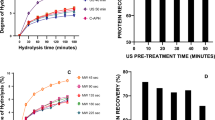Abstract
In the present work, cassava leaves were treated with 0.5 kg ammonia/kg dry matter at 78 °C and 30% moisture content in a 2-kg reactor. Protein extraction was carried out with a calcium hydroxide solution (pH 10) for 30 min at several temperatures (30 °C, 45 °C, 60 °C, 75 °C, and 90 °C) and solid/liquid ratios (1:10 and 1:15) in a thermostatized bath. Soluble protein content of the extracts was determined by Lowry’s method. Dry substrate concentrations of 5%, 7.5%, and 10% and enzyme doses of 2 and 5 IU/g dry matter were used for the enzymatic hydrolysis in an orbital incubator at 50 °C and 100 rpm. Both cellulase and xylanase were used. Reducing sugars produced were determined with the dinitrosalicylic acid method. The highest protein extraction yield for the ammonia-treated leaves was 29.10%, which was 50% higher than with the untreated leaves (20%), and was obtained at 90 °C with a 1:10 solid/liquid ratio. The concentrate had a protein content of 36.35% and the amino acid profile was suitable for swine and poultry. The highest sugar yield was 54.72% with respect to theoretical and was obtained with 5% solids and an enzyme dose of 5 IU/g dry matter. This yield was 3.4 times higher than the yield of the untreated leaves (16.13%). These results indicate that cassava leaves have a great potential for animal feeding and ethanol production. Both protein extraction and sugar yields may be enhanced by optimizing the ammonia treatment.



Similar content being viewed by others
References
FAO. (2008). Food and Agriculture Organization of the United Nations. News release 08-82. FAO Media Office. Rome. July 25.
Ravindran, V. (1992). FAO animal production and health paper 95. Rome, pp. 111–126.
Mastrodi, J., & Correa, A. (1986). Archivos Latinoamericanos de Nutricion, 36, 483–494.
Achidi, A. U., Ajayi, O. A., Maziya-Dixon, B., & Bokanga, M. (2008). Journal of Food Processing and Preservation, 32, 486–502. doi:10.1111/j.1745-4549.2007.00165.x.
Urribarrí, L., Ferrer, A., & Colina, A. (2005). Applied Biochemistry and Biotechnology, 121/124, 721–730. doi:10.1385/ABAB:122:1-3:0721.
Correa, A. D., dos Santos, S. R., de Abreu, C. M. P., Jokl, L., & dos Santos, C. D. (2004). Ciencia e Tecnologia de Alimentos, 24, 159–164.
Ferrer, A., Byers, F. M., Sulbarán de Ferrer, B., Dale, B. E., & Aiello, C. (2000). Applied Biochemistry and Biotechnology, 84/86, 163–179. doi:10.1385/ABAB:84-86:1-9:163.
Covenin 1156–79 (1979). Alimentos para animales. Determinación de humedad. Venezuela: Ministerio de Industrias Ligeras y Comercio.
A.O.A.C. (1980). 13th Ed. Association of Official Analytical Chemists. pp. 125.
Goering, H. K., & Van Soest, P. J. (1970). Agric. handbook, vol. 379. Washington, DC: ARS-USDA.
Lowry, O., Rosebrough, N., Farr, A., & Randall, R. (1951). The Journal of Biological Chemistry, 193, 265–275.
Miller, G. (1959). Analytical Chemistry, 31, 426–428. doi:10.1021/ac60147a030.
Urribarrí, L., Ferrer, A., & Colina, A. (2004). Revista de la Facultad de Agronomia, 21, 264–275.
Pico Tag Work Station. (1984). Operator’s Manual. Waters Publications. U.S.A. Chapter 3. 22 p.
National Research Council (1998). Subcommittee on swine nutrition (10th ed.). Washington, DC: National Academies.
National Research Council (1994). Subcommittee on poultry nutrition (9th ed.). Washington, DC: National Academies.
Ferrer, A., Byers, F., Sulbarán de Ferrer, B., Dale, B. E., & Aiello, C. (2002). Applied Biochemistry and Biotechnology, 98/100, 123–134. doi:10.1385/ABAB:98-100:1-9:123.
Sun, Y., & Cheng, J. (2002). Bioresource Technology, 83, 1–11. doi:10.1016/S0960-8524(01)00212-7.
Ballesteros, M., Oliva, J. M., Negro, M. J., Manzanares, P., & Ballesteros, I. (2004). Process Biochemistry, 39, 1843–1848. doi:10.1016/j.procbio.2003.09.011.
FAO (2008). Food and Agriculture Organization of the United Nations. The State of Food and Agriculture. Biofuels: prospects, risks and opportunities. Rome: Electronic Publishing Policy and Support Branch—FAO.
Acknowledgments
Financial support from CONDES (University of Zulia, Maracaibo, Venezuela), INIA (Maracaibo, Venezuela), and INZIT (Maracaibo, Venezuela) is greatly acknowledged. We are very grateful to Leonardo Zarrameda in INIA-ZULIA for supplying the cassava leaves.
Author information
Authors and Affiliations
Corresponding author
Rights and permissions
About this article
Cite this article
Urribarrí, L., Chacón, D., González, O. et al. Protein Extraction and Enzymatic Hydrolysis of Ammonia-Treated Cassava Leaves (Manihot esculenta Crantz). Appl Biochem Biotechnol 153, 94–102 (2009). https://doi.org/10.1007/s12010-008-8422-x
Received:
Accepted:
Published:
Issue Date:
DOI: https://doi.org/10.1007/s12010-008-8422-x




